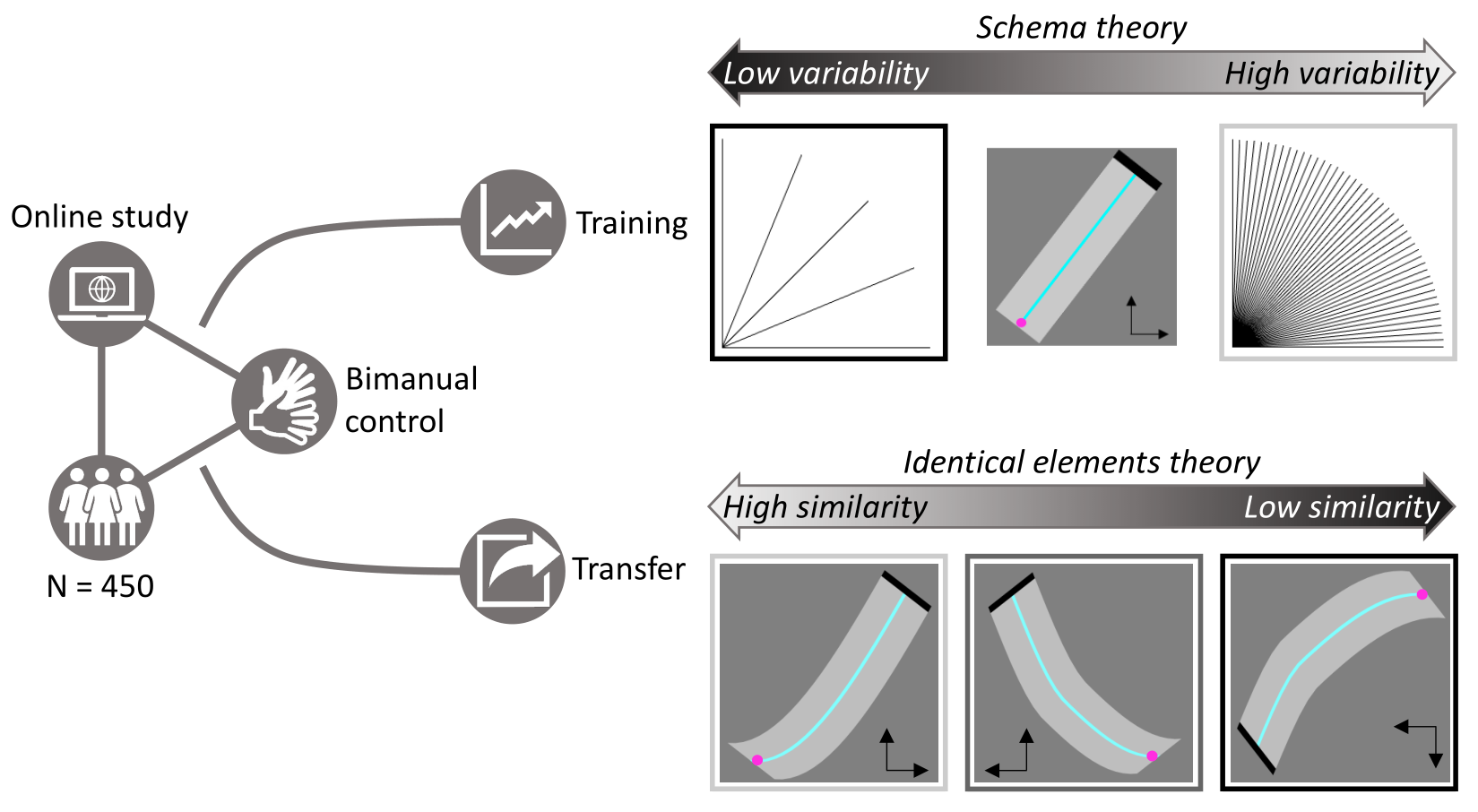Bimanual motor task comprising 5 learning and 3 transfer conditions (behavioural data)
Data for each subject of the pilot experiment (N=75, 5 per condition) and the final experiment (N=450, 30 per condition) are provided as raw data as .csv file.
We used a between-subject design with five training tasks (Train-I, Train-II, Train-III, Train-IV, Train-V) and three transfer tasks (Transfer-S, Transfer-M, Transfer-L), resulting in fifteen individual conditions (each N=30).
Condition coding:
- Condition 01: Train-I & Transfer-S
- Condition 02: Train-I &Transfer-M
- Condition 03: Train-I &Transfer-L
- Condition 04: Train-II &Transfer-S
- Condition 05: Train-II &Transfer-M
- Condition 06: Train-II &Transfer-L
- Condition 07: Train-III &Transfer-S
- Condition 08: Train-III &Transfer-M
- Condition 09: Train-III &Transfer-L
- Condition 10: Train-IV &Transfer-S
- Condition 11: Train-IV &Transfer-M
- Condition 12: Train-IV &Transfer-L
- Condition 13: Train-V &Transfer-S
- Condition 14: Train-V &Transfer-M
- Condition 15: Train-V &Transfer-L
Training tasks:
Across all training and transfer tasks, the aim was to navigate a cursor on a street as fast and accurately as possible. All training tasks comprised only straight streets angled between 0° and 90°, whereby the street angles reflected the level of bimanual coordination. Specifically, only one hand was required for the angles 0° and 90°, both hands were required equally for an angle of 45°, and all other angles correspond to more complex interactions between the two hands. The five training tasks differed in their minimum angular difference between streets (Train-I: 22.5°, Train-II: 18°, Train-III: 11.25°, Train-VI: 6.425°, Train-V: 2°), which meant that across the five training tasks, the number of streets differed. For example, Train-I comprised five different streets with street angles of 0°, 22.5°, 45°, 67.5°, 90°, while Train-V comprised 46 different streets (0°, 2°, 4°, ... 90°). The order of streets was pseudo-randomized, such that all streets within one training task were repeated equally, and with a minimum of 22.5° between concurrent streets to avoid street-to-street carry-over effects.
The training task was performed for 100 trials. Each trial equalled one path comprising six streets. At the beginning of each street, the cursor was at the starting position (i.e., in the middle of the width of the path, at the bottom-left position). The cursor could be moved upwards and to the right using the two keys. If the cursor hit either side of the street, the cursor was reset to the starting position.
Transfer tasks:
All transfer tasks comprised only curved streets. The transfer task was performed for 5 trials before and 5 trials after training. Each trial comprised six slightly different curves, whereby their order was pseudo-randomized. The trial structure was identical to the training tasks.
The three transfer tasks differed in their similarity to the training tasks, which was implemented by changing the direction of cursor movement. Thus, for Transfer-S cursor direction was the same as in the training tasks, i.e., upwards and to the right. Transfer-M had one cursor direction transposed, i.e., upwards and to the left, wherefore the streets from Transfer-S were flipped along the vertical axis. Finally, Transfer-L had both cursor directions transposed, i.e., downwards and to the left, wherefore the streets from Transfer-S were flipped along both the vertical and horizontal axis.
Data import:
Data was imported manually to MATLAB by double clicking on the .csv file with ‘comma’ as column delimiters and with output type as ‘column vectors’. Note, that the questionnaire for bimanual competence (BIMquestion1, BIMquestion2, BIMquestion3, ...) has to be imported as text.
Questionnaire data:
Two questionnaires, the Bimanual competence questionnaire and the Achievement motivation inventory were performed.
Bimanual competence questionnaire as published by Schoenfeld et al., (2021)
The dependent variables BIMquestion1, BIMquestion2, …, BIMquestion16 correspond to the following questions:
- BIMquestion1 to BIMquestion4: Do you currently play games involving both of your hands (sports, hobbies, etc)?
- BIMquestion5 to BIMquestion8: Do you currently do any typing using both of your hands, e.g., on the keyboard, or texting using both thumbs, e.g., on your phone?
- BIMquestion9 to BIMquestion12: Do you currently play (a) videogame(s) involving both of your hands (on a computer, PlayStation, etc)?
- BIMquestion13 to BIMquestion16: Do you currently play (a) musical instrument(s) involving both of your hands?
Achievement motivation inventory was assessed as published by Schuler and Prochaska, 2001 (translated from German 'Leistungsmotivationsinventar (LMI)'). The responses are included in AMI_sliderresponse.
Experimental data contain the following variables:
- ResInd = Number of resets per trial
- MTime = Movement time (from start to end of the cursor movement)
- Error = Distance between the cursor and ideal line
- Angle = Angle of the street
Trial order pilot experiment:
The trial index is coded in the column termed ‘blocks.thisN’ starting with 0
- Trial 0-1: orientation trials with 6 straight streets (0°, 90°, 45°,45°, 22.5°, 67.5°)
- Trial 2-6: 5 pre-transfer trials
- Trial 7-106: 100 trials training task
- Trial 107-111: 5 post-transfer trials
Trial order final experiment:
The trial index is coded in the column termed ‘blocks.thisN’ starting with 0
- Trial 0: orientation street for transfer pre (1 curved street)
- Trial 1-5: 5 pre-transfer trials
- Trial 6: orientation street for the training task (45°)
- Trial 7-106: 100 trials training task
- Trial 107: orientation street for transfer post (1 curved street)
- Trial 108-112: 5 post-transfer trial
References:
Schoenfeld, M. J., Grigoras, I.-F., Stagg, C. J., & Zich, C. (2021). Investigating different levels of bimanual interaction with a novel motor learning task: A behavioural and transcranial alternating current stimulation study. Frontiers in Human Neuroscience, 15.
Schuler, H., and Prochaska, M. (2001). Leistungsmotivationsinventar: LMI; [Dimensionen berufsbezogener Leistungsorientierung]. Göttingen: Hogrefe.
We welcome researchers wishing to reuse our data to contact the creators of datasets. If you are unfamiliar with analysing the type of data we are sharing, have questions about the acquisition methodology, need additional help understanding a file format, or are interested in collaborating with us, please get in touch via email. Our current members have email addresses on our main site. The corresponding author of an associated publication, or the first or last creator of the dataset are likely to be able to assist, but in case of uncertainty on who to contact, email Ben Micklem, Research Support Manager at the MRC BNDU.

Creative Commons Attribution-ShareAlike 4.0 International (CC BY-SA 4.0)
This is a human-readable summary of (and not a substitute for) the licence.
You are free to:
Share — copy and redistribute the material in any medium or format
Adapt — remix, transform, and build upon the material for any purpose, even commercially.
This licence is acceptable for Free Cultural Works. The licensor cannot revoke these freedoms as long as you follow the license terms. Under the following terms:
Attribution — You must give appropriate credit, provide a link to the license, and indicate if changes were made. You may do so in any reasonable manner, but not in any way that suggests the licensor endorses you or your use.
ShareAlike — If you remix, transform, or build upon the material, you must distribute your contributions under the same licence as the original.
No additional restrictions — You may not apply legal terms or technological measures that legally restrict others from doing anything the licence permits.

